This is a Minolta XD11, a 35mm Single Lens Reflex camera produced by Minolta of Japan from 1977 to 1984. The XD11 was the first model in Minolta’s new XD series of electronic manual focus cameras. It was the first SLR camera with both aperture and shutter priority auto exposure, plus manual control. Prior auto exposure cameras had one or the other. The XD11 was a technologically advanced camera, and offered a peak at future technologies that would soon be common in professional and consumer level Minolta SLRs.
Film Type: 135 (35mm)
Lens: 50mm f/1.4 Minolta Rokkor-X PG coated 7 elements in 5 groups
Lens Mount: Minolta MD Bayonet
Focus: 1.75 feet to Infinity
Viewfinder: Fixed SLR Pentaprism with full information display and LED aperture scale readout
Shutter: Vertically Traveling Metal Blade
Speeds (Manual): X, B, 1 – 1/1000 seconds, plus 1/100 mechanical “O-speed”
Speeds (Automatic): 1 – 1/1000 seconds, step less
Exposure Meter: TTL Silicon Photo Cell with Aperture and Shutter Priority Automatic Exposure
Battery: (2x) 1.5v LR44 Silver Oxide Battery
Flash Mount: Hot shoe with PC-sync port for flashbulbs, 1/100 X-sync
Weight: 878 grams (w/ lens), 569 grams (body only)
Manual: https://www.cameramanuals.org/minolta_pdf/minolta_xd-11.pdf
How these ratings work |
Upon it’s release, the Minolta XD11 was a state of the art 35mm SLR with all the modern conveniences available at the time. With classic styling, excellent ergonomics and performance, and a long list of features, it remains a popular option for film photographers and collectors alike. Whether you already have a large selection of Minolta bodies and lenses, or if this is your first manual focus 35mm SLR, the XD11 remains one of the best ever made, by any company and one that I highly recommend! | ||||||
| Images | Handling | Features | Viewfinder | Feel & Beauty | History | Age | |
| 2 | 2 | 2 | 2 | 2 | 1 | 0% | |
| Bonus | +1 for overall perfection, one of the best 35mm SLRs ever made | ||||||
| Final Score | 12.0 | ||||||
History
 The Minolta XD11 is the second generation of Minolta SLRs developed in cooperation with Ernst Leitz of Germany, which began in 1972. Back then Minolta had a desire to compete more heavily in the premium rangefinder market dominated by the Leica M-series, and Leitz was struggling with the high cost and slow speed of manual assembly that the company had been using for decades. The Japanese camera market had established a much faster and more cost efficient system of automation in assembly lines, something that the Germans weren’t used to, and Minolta sought the prestige of a highly respected German company to help them differentiate their products in an increasingly competitive Japanese market.
The Minolta XD11 is the second generation of Minolta SLRs developed in cooperation with Ernst Leitz of Germany, which began in 1972. Back then Minolta had a desire to compete more heavily in the premium rangefinder market dominated by the Leica M-series, and Leitz was struggling with the high cost and slow speed of manual assembly that the company had been using for decades. The Japanese camera market had established a much faster and more cost efficient system of automation in assembly lines, something that the Germans weren’t used to, and Minolta sought the prestige of a highly respected German company to help them differentiate their products in an increasingly competitive Japanese market.
The first product of this joint cooperation was the Leica CL and Minolta CL, released in April and November 1973 respectively. Although only a few lenses were developed specifically for the CL-series, almost every M-mount lens was compatible for it, save for a few special purpose lenses. An estimated 35,000 Leica CLs were sold in it’s first year, not counting any Minolta branded models with a total production of about 65,000 units. The cameras were discontinued only 3 years after their release, because their lower cost was having a negative impact on Leitz’s more expensive M-series.
Although the CL-series was successful, the market for premium rangefinders was getting very small as photographers heavily favored the Single Lens Reflex. The need to develop an SLR was not lost on Leitz and like nearly every other company, in 1964 they developed their own model called the Leicaflex, which like their rangefinder models, was slow to build and came with a very high price.
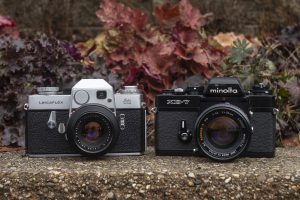
Around this same time, Minolta was working on an all new 35mm SLR to replace their aging SR/SR-T series and in 1974 released the Minolta XE (this was it’s Japanese name, it was called the XE-1 in Europe and XE-7 in North America). The XE was an expensive and well featured model that the company positioned right beneath their top of the line professional Minolta XK.
Per their earlier agreement, in 1976 Leitz would release their version of the XE, which they called the R3 using the same body and shutter, but with a different lens mount and metering system. Although sharing a lot of the same technology, Minolta built their cameras in Japan and Leitz built theirs initially in Germany, and later in a Leitz factory in Portugal.
Both the Minolta XE and Leica R3 were successful, but as SLR technology rapidly evolved in the mid 1970s with newer models favoring smaller, more compact designs and having more advanced auto exposure systems, their relevance in the market quickly disappeared. In 1977, Minolta would discontinue the XE, replacing it with an almost entirely new model, which was sold in Japan as the XD, the XD7 in Europe and as the XD11 in North America. Leitz would continue production of the R3 until 1979 at which time they would release the R4 which was also built in collaboration with Minolta.
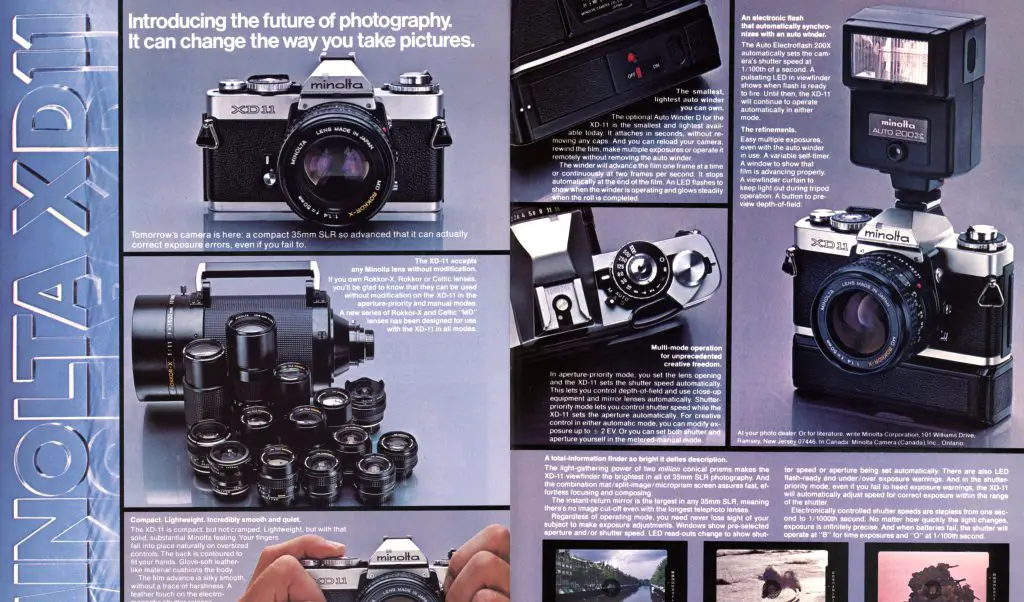
The all-new XD11 shared very little in common with the XE-7 despite being released only three years later. The body was smaller and used more lightweight plastic and composite parts to both reduce weight and cost. It had an all new Silicon Photo Diode light meter that was more responsive and had a greater range than the dual CdS meters of the earlier camera. In addition to Aperture Priority auto exposure, it also added Shutter Priority auto exposure, the first Japanese SLR to offer both. Along with the new shutter priority mode, a revised lens mount was used called the MD-mount, which was an update to the earlier MC and even earlier SR-mounts adding an external lever used to index the maximum aperture of the lens, which is necessary for Shutter Priority, and later Programmed Auto Exposure modes. Like the earlier XE-7, it had a full information viewfinder and a motor drive coupling on the camera’s base plate meaning it had appeal for professional photographers as well
The XD11 was Minolta’s most ambitious camera to date, and upon it’s release was promoted as being the future of photography. People wouldn’t know it at the time, but Minolta’s investment in new state of the art features would foreshadow the company’s innovative progress in the coming decades with programmed AE, auto focus, cameras that talked, and eventually, digital cameras.
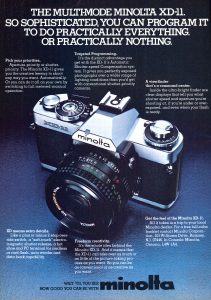
In March 1979, the Minolta XD11 carried a retail price with f/1.7 and f/1.4 lenses of $690 and $754 respectively. Chrome bodies came with a $30 discount. These prices when adjusted for inflation compare to $2675 and $2925 today making them quite an expensive option for all but the most serious photographers.
Two variations of the XD/XD7/XD11 were eventually released. The first was a Japanese only XD-s whose only change was an adjustable diopter on the back in place of the viewfinder blind, and in 1979 a second model called the XD5 which was a scaled down version of the XD11. The XD5 removed six notable features, which some collectors theorize that it’s name comes from XD11 minus 6 equals XD5. Whether this is what Minolta had planned, or if it is just a neat coincidence is anyone’s guess.
Upon it’s release, the Minolta XD11 turned a lot of heads. While many companies had been slowly inserting new technologies into their cameras such as light weight composite materials, CPU controlled meters, and other electronic features, the Minolta XD11 raised the bar for what a modern SLR should be with a whole host of new technologies.
Nearly every photographic publication posted their own reviews of the camera, all introducing the camera’s new features, and how they could be effectively used. In the PDF below are 19 pages from three different reviews published in Popular and Modern Photography between December 1977 and January 1979 covering the camera’s features.
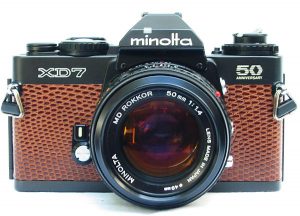
In 1979, in celebration of Minolta’s 50th anniversary when the company was first known as Nichidoku Shashinki Shōten (the name Minolta would not be used until the early 1930s), special 50th anniversary editions of the XD-series were made available worldwide. All 50th anniversary models featured an additional logo on the front place, were painted black, and some received factory lizard-skin body coverings.
The XD-family was produced for quite a long time, eventually being discontinued in 1984, three years after the electronic X-700 from 1981. Throughout it’s life, some minor changes were made to the XD-family including a change from the grippy soft body covering to a harder and more durable type, different kinds of shutter blades with dimples in them, and in the very last models, a change to Minolta’s new “sun” logo, instead of the earlier italicized logo.
Today, there’s no shortage of Minolta SLR fans. With a huge number to select from between the SR-2’s release in 1958 and the last auto focus Minolta SLRs, many collectors and users have varying opinions on which model is their favorite. Whether you are on “Team XD11” or not, I cannot imagine anyone having much to dislike about this camera as it is an example of a camera that has retained it’s greatness throughout it’s entire life. This was an advanced camera with a lot to offer in 1977, a claim that still applies in 2021.
My Thoughts
Whenever the topic of “What is the best {type of camera} or {brand of camera} ever made” comes up, the number of answers given inevitably match that of the number of responses. No one can ever agree on a single answer because what is the best for one person isn’t going to be for another. The best of anything is objective, and for most things and people, simply doesn’t exist as what’s best for one person or one situation will change depending on the circumstances.
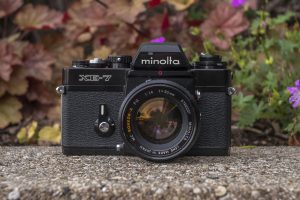
I’ve reviewed a lot of Minolta SLRs from the SR-7 to the Maxxum 7000 (I’ve actually shot several SLRs newer than that, but just haven’t gotten around to reviewing them yet) and they’re all good. Minolta never made a bad SLR as they were an A-list company who was frequently at or near the front of the world camera industry.
I like all my SLRs, and since we’ve established that no one single model can be the best, what if I just ask which one is my favorite? It’s not the SR-7 because that is a big and heavy camera that doesn’t lend itself to quick and easy operation. It’s not the Maxxum 7000 because for as innovative of a camera as it was when it was released, it’s plastic and rubber body doesn’t age well and doesn’t win any beauty contests for me, plus it’s early auto focus system is easily tricked.
As is the case with many brands, my favorite models generally are those with an even blend of classic styling and operation, but with some semblance of modern conveniences. The Nikon EL2, Canon EF, and Olympus OM-4 are all favorites of mine for this very reason. But what about Minolta? I’m not yet ready to declare the XD11 the winner, but looking at it on paper, it certainly makes a compelling case for itself.

Starting with the top plate, the layout of the controls is very modern with every dial and button’s purpose, logically located. On the left is the rewind knob with folding handle, and beneath the ASA film speed dial. The XD11 predates DX coding, so film speeds 12 to 3200 must be manually selected. A small chrome button below and to the right of the dial is a lock preventing accidentally changes to the film speed. Also on the film speed dial, opposite the lock button is a little lever allowing you to select -2 to +2 EV for instances where intentional under and overexposure are desired.
Above the pentaprism is the flash hot shoe which electronically syncs with the shutter at speeds up to 1/100. To the right of the prism is the shutter speed dial, with manual speeds from 1 second to 1/1000, plus Bulb. Two additional settings are available, a red X position which activates a special 1/100 electronic flash sync speed, and an O position which is a mechanical speed which also fires the shutter at 1/100, allowing the camera to still be used if the batteries are dead. When the camera is in this O mode, combined with either shutter priority or manual modes, the letter “O” will appear inside of the viewfinder near the lower right corner.
By far, one of my favorite features of the XD11 is a feature I also applauded on the Canon EF, Leica M5, and Nikon FG, which is that the shutter speed dial extends slightly beyond the front edge of the top plate, allowing your right index finger to easily change shutter speeds with the camera to your eye. I love this feature and is one that I wish more SLRs had.
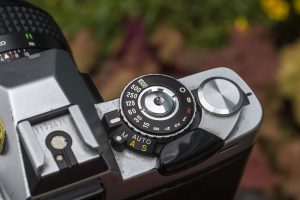
Around the outer edge of the shutter speed dial is a switch that selects both Shutter Priority AE, Aperture Priority AE, and full Manual mode. A scale on the right side of the viewfinder shows shutter speeds in both Manual and Aperture Priority modes. When this switch is in the Shutter Priority position, the scale inside of the viewfinder changes to show f/stops.
In the center of the shutter speed dial is a large chrome shutter release button with a threaded socket in the center for a cable release. Although it looks similar to the electromechanical shutter release from the Minolta XG7 which reacts to the presence of your finger, the shutter release on the XD11 is a physical button that activates the meter only when half pressed.
Finally, on the far right is the film advance lever and to it’s right the automatic resetting exposure counter.
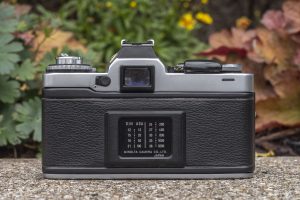
The back of the camera has a small switch to the left of the eyepiece that activates an eyepiece blind which blocks unwanted light from entering the viewfinder when using long shutter speeds, and on the far right, beneath the film advance lever, a safe load indicator that will show a red line if film is loaded into the camera and transporting correctly. On the back of the door is a plastic box end frame to remind you what kind of film is loaded into the camera. Behind the frame is a DIN to ASA conversion chart.
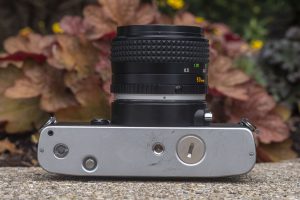
Flip the camera over and on the bottom there is the round battery compartment cover, a centrally located 1/4″ tripod socket, rewind release button and the motor drive coupling. With the optional Auto Winder D, film advance is automatically completed after each shot without having to use the film advance lever.
Opening the film compartment requires a firm upward tug of the rewind knob and the right hinged door swings open. The image to the left was taken before I replaced the light seals, which was necessary on this example as they had badly crumbled. I definitely recommend doing this to any XD11 you might find as it’s unlikely any are still doing their job of keeping light leaks out.
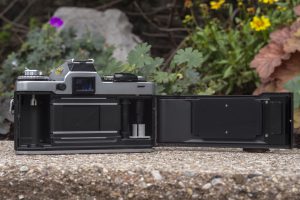
Film transport is from left to right onto a fixed take up spool with a unique two piece design in which a gray plastic bottom piece has four notched slots which are used to grip the film leader from a new roll of film for easy loading. Although not the same as the quick load feature found on other cameras, Minolta’s solution works really well as all you need to do is get the leader to rest in any of the four slots and with a single wind of the lever, the leader will get pulled onto the spool. The take up spool rotates clockwise which is opposite the direction the film is in the cassette, which is said to help with film flatness as it travels through the camera.
The inside of the door has a very large and dimpled film pressure plate which helps minimize resistance as film transports through the camera. Lastly, on the door hinge itself is a release pin which allows you to remove the door entirely, for use with the Minolta Data Back D which adds a date feature.
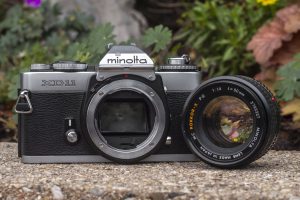
The Minolta XD11 was the first Minolta SLR to use the Minolta MD mount, which is really an evolution of their original SR mount first used in the Minolta SR-2 from 1958. All manual focus Minolta SLR lenses are interchangeable between all Minolta SLRs up until the Maxxum series which switched to an entirely different mount. The original SR mount was revised twice, the first in 1966 which added a coupling to allow for open aperture metering. Lenses with this coupling are called MC lenses. The second added a second lever which is used to index the maximum aperture of the lens, which is necessary for both Shutter Priority and Programmed Auto Exposure modes.
Like most SLR bayonets, removing a lens requires the press of a button which is located near the 2 o’clock position around the lens mount, and a quick counterclockwise twist. I have found that on nearly all of my Minolta SLRs, more effort is required to mount and remove lenses, compared to other bayonet mounts by Nikon, Olympus, or other companies.
Also on the front of the camera, near the 4 o’clock position around the lens mount is a depth of field preview button, and finally a self-timer lever to the left of the lens mount.
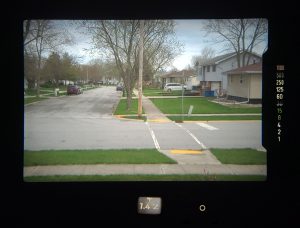
The viewfinder in the XD11 has all the modern conveniences of the day, including an aperture “Judas window” that reads the selected f/stop directly off the lens, and a scale along the right that shows either shutter speeds in both full Manual and Aperture Priority Mode, and f/stops in Shutter Priority Mode. Selected shutter speeds or f/stop values as detected by the camera’s meter are indicated by a red LED. If a selected speed or value is beyond the capability of the scale a triangular arrow will appear to indicate over or under exposure. With the camera in either Manual or Shutter Priority Mode, the selected shutter speed will appear to the right of the aperture Judas window. In the image to the left, I have it in the “O” position, but any speed from 1 – 1000 will show in the same location.
The camera has both a split image and microprism collar for focusing, and an extremely bright and easy to use laser etched ground glass. The brightness is even across the frame, even in the corners and is easy to use even in low light. While I won’t say it’s brighter than other SLRs of it’s era, but it’s definitely equal to the best of what you could buy in 1977 when this camera was first released.
The only issue I had with the viewfinder is one that was common in nearly all 1970s SLRs with shutter speed or f/stop scales that use light entering the lens, which is that in poor lighting, it can be difficult to see the scale as it was not backlit. Backlit LED and LCD displays would not begin to be common for another couple of years. I don’t hold this against the XD11, but for the first time user whose never used a camera this old, it can be disappointing to not easily be able to see the scale in low light.
The Minolta XD11 has a lot going for it. Upon it’s release it was Minolta’s most advanced SLR they had ever made, and today, with the benefit of hindsight, was a highlight of their entire SLR line. The company would continue to innovate with more advanced exposure modes, auto focus, and other features, but the for many, the XD11 is the perfect mid-point between old and new.
Repairs
I have had two different Minolta XD11s over the years and both had the same issue which is a short delay between pressing the shutter release, the lens stopping down, and the shutter firing. Although only a fraction of a second, this delay was part of the reason I sold the first one and waited a couple of years before getting this second one. I didn’t realize it until after getting the second one that the fix is pretty simple and something that I felt comfortable attempting, despite my usual hesitation with opening up electronic SLRs,
To show the delay before I cleaned the camera, check out these two videos, the first shows the camera with no lens attached. In this video, I fire the shutter at both 1/4 and 1/500 seconds and in both cases, there is a delay between when the aperture lever (the thing at the bottom of the lens mount) moves, and the mirror moves. Both these things should occur almost instantaneously as the aperture lever stops down the lens, and the mirror has to get out of the way before the shutter can fire.
This second video shows the same thing, but through the viewfinder. Here, it is more obvious that the lens is stopping down for a moment before the mirror lifts. This won’t negatively impact the exposure as the shutter timing is still correct, but the short delay between pressing the shutter release and the shutter actually firing can cause you to miss a fast action shot, plus, it’s just annoying.
If you have an XD11 with this same problem, the fix is to remove the plate around the shutter and clean a small metal piston inside of a cylinder which acts as a dampener for the the mirror to go up and down. Over time, debris can get into this cylinder, slowing down the piston inside which causes the delay seen in the two videos above.
This repair can be done with a set of precision screwdrivers and some kind of solvent such as lighter fluid, naphtha oil, or rubbing alcohol to clean the cylinder. As with any repair, be sure to have a well lit and clean working space, a place to safely organize and store the small screws, and try not to work in an area with carpeting as if you drop a screw on the floor, you likely won’t be able to find it!
The first steps are to remove the pieces necessary to gain access to the cylinder. In the images below, remove the red screws above the mount and the two yellow screws on the base plate and set aside. Don’t worry about the battery cover as it will come with the bottom plate. Next remove the four blue screws holding the bayonet and set aside. Lift up and set aside the chrome ring indicated by the orange arrows and set aside. Pay attention to the orientation of this ring as it can only go back on exactly as pictured.
Finally, lift up on the black plastic ring indicated by the pink arrows. Pay close attention when removing this plastic ring as there is a long spring attached to it on the underside which will definitely come off. When you put this back together, this spring must be attached to a little slit in the plastic ring. It is not hard to do, but must be done.
Next, you must lift off the black plastic outer cover that surrounds the lens mount indicated by green arrows. This cover is held on by a small amount of adhesive so you need to peel it off. On the side of the camera with the flash sync port, lens release button, and depth of field button, you must navigate the cover around the flash sync port, but both buttons will come off with the cover.
With the cover off, on the side near the self timer, you will see a piece of black fabric tape which covers the cylinder. Peel it back and now you can see the cylinder. In the third picture below, a metal piston is inside of a black cylinder indicated with a red X. A yellow X indicates a rocker arm that holds the piston in place. The piston is not physically connected to anything and comes out inside of the cylinder when you remove them both together after removing the two white screws.
In first two pictures in the gallery below, you can see the piston in it’s resting position after removing the cylinder, and then both pieces out of the camera. Give the piston and the inside of the cylinder a good cleaning with your solvent of choice and be sure to keep any debris from getting in there. Once everything is dry, you reassemble in the opposite of how you took things apart.
With the piston inside of the cylinder, make sure the bottom is resting against the rocker arm indicated with the yellow X. Slide the cylinder and piston together back into the camera and replace the two white screws. When putting the black ring that the long spring was attached to back into the camera, there is just enough play to be able to lift it up to make sure spring is secured to it. If you are struggling to see how the spring attaches, the third picture below shows a side view of the spring properly installed, with the side cover off. You would not normally install the spring with the side cover off, so make sure you have the cover on before proceeding.
You’ll know you did it right if the aperture coupling pin near the top of the lens mount springs back into position if you move it with your finger. If it moves freely with no tension, the spring is not connected. Once the spring is in position, reassemble the camera and you’re done!
In this final video, I show the XD11 after it has been cleaned. Notice that with the lens off, the aperture lever and the mirror begin to move at almost the exact same time. Through the viewfinder, the short delay where the lens has stopped down before the mirror lifts, is gone.
My Results
The first time I took the Minolta XD11 out, I loaded in an expired roll of a film called Scotch 200, which I found out later was a relabeled Ferrania emulsion. I had picked up a couple rolls of this film at an estate sale a while back and had shot a few of them in other cameras and got pretty good results, especially for an expired color film.
I loaded it into the XD11 and took it with me on a trip downtown Chicago back in the summer of 2018 where I used it much like a tourist seeing the big city for the first time might.
This roll of Scotch 200 film was expired by about 20 years, but has done a remarkable job of surviving that time with only a slight hint of a cooler color shift. The color palate had a subdued blue cast that gave them a slightly darker, but very pleasing look. Sadly, this would be the last roll of this film I had, but has been on my list of expired films to look out for.
Having shot this first roll of film nearly 3 years ago, I thought before putting out this review, I should shoot something more recently, I loaded in some bulk Rollei RPX25 that I had picked up over the weekend. My favorite black and white film is Kodak Panatomic-X, which is a very fine grain ASA25 speed film, but hasn’t been made in decades and is getting harder and harder to find, so in an effort to find something comparable, the Rollei film comes close.
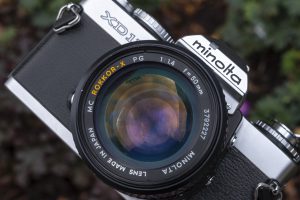
As for the camera itself, the XD11 was great. About half of these images from both galleries were shot with the 50mm f/1.4 Rokkor-X seen throughout this article, but a few were taken with a 28mm third party lens which were a tad softer. The front image of Central Camera and one of the American flag photo are two examples of this. Initially I wasn’t going to include them in the review, but I thought it emphasized how much better first party lenses are than some third party ones, plus I liked the framing of both images. Oh, and just in case someone is screaming at me for crawling under a train car to get the shot above, this is a retired train car in a park that is permanently fixed to the ground, so I was not at risk!
Having the option for both shutter priority and aperture priority was nice to have, although I must admit I’m more of an aperture priority guy so that’s what I used while shooting the camera. I’d much rather control depth of field and sharpness and let the camera pick an appropriate shutter speed than the other way around. Had I done some sports photography with lots of fast action, shutter priority would have been more useful. I did appreciate how the LED scale within the viewfinder changes between the two modes to show shutter speeds in aperture priority mode, and f/stops in shutter priority.
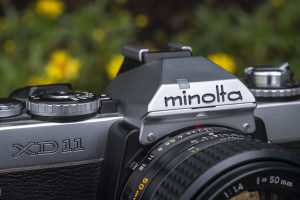
Having the appearance of an all metal camera, Minolta emphasized XD11’s light weight and compact design heavily in the promotion of this camera. Although I consider myself a huge fan of the much larger and heavier XE-7, the XD11’s smaller size makes it more portable and convenient to carry around on long day adventures. The camera fits perfectly into my hands with all the camera’s controls in easy reach of my fingers. About the only thing that could have improved the ergonomics of the XD11 would have been some sort of hand grip on the front of the camera like the Canon A-1 had. That certainly doesn’t mean it needs it, as I never once felt I didn’t have a secure grip while walking the streets of downtown Chicago, but it would have been an extra bonus.
Regular readers of this site will know that I heavily value a bright and easy to use viewfinder and the XD11 has one of the best I’ve used. In my review for the Minolta XE-7, I gave high marks for it’s evenly bright viewfinder, but the XD11’s is even brighter. Minolta’s marketing material claims that the viewing screen uses some type of “scientifically developed matte screen” that claims to be 50% brighter than other screens. What amount it is brighter, I can’t say for sure, but it’s very good.
I have no major, or even minor complaints about the XD11. Any criticisms I have of the camera fall into the nit-pick category of which there are two. The first is that whatever synthetic body covering Minolta used on their late 1970s SLRs (not just the XD11) it tends to shrink over time, giving cameras like mine a shoddy look and requiring a new skin to look as good as new. This is a shame too, because whatever material this is, it has a nice grip to it, making the camera extremely comfortable to hold. It’s probably not fair to criticize a body covering that doesn’t survive over four decades, but like I said, nit picks.
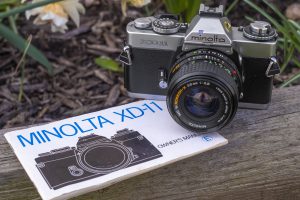
The second is that I have never been a fan of the “Judas window” method that many companies used during this time to be able to see selected f/stops through a small hole in the front of them prism. It not only breaks up the look of an otherwise excellent viewfinder, but because it takes light from a different source as the rest of the viewfinder, sometimes the numbers can be hard to see. Many other companies used these peepholes too, so this it’s not just Minolta, and perhaps other methods greatly add to the complexity and cost of the camera, but I just don’t like them.
The Minolta XD11 is an outstanding camera, and one of the best I’ve ever used. It compares favorably to other advanced modern manual focus SLRs by other companies like the Canon A-1, Nikon FA, and Olympus OM-4 which is especially impressive considering both the FA and OM-4 came out nearly half a decade later. For it’s time, the Canon A-1 was the XD11’s best competition and with what I consider to be slightly better ergonomics, plus the availability of a mechanical Bulb and 1/100 shutter speed, you are not dead in the water without power, like you are with the Canon A-1.
I hate saying something is the best of anything, but I’ll be damned if I cannot find another camera with a better combination of features, usability, good looks, and performance of the XD11. Highly recommended!
Related Posts You Might Enjoy
External Links
http://camera-wiki.org/wiki/Minolta_XD_series
http://www.rokkorfiles.com/XD11.html
https://blog.jimgrey.net/2021/08/27/minolta-xd-11/
https://www.japancamerahunter.com/2016/10/camera-geekery-minolta-xd-11-review/
http://www.mir.com.my/rb/photography/hardwares/classics/minoltaxd711/basicimages/index.htm

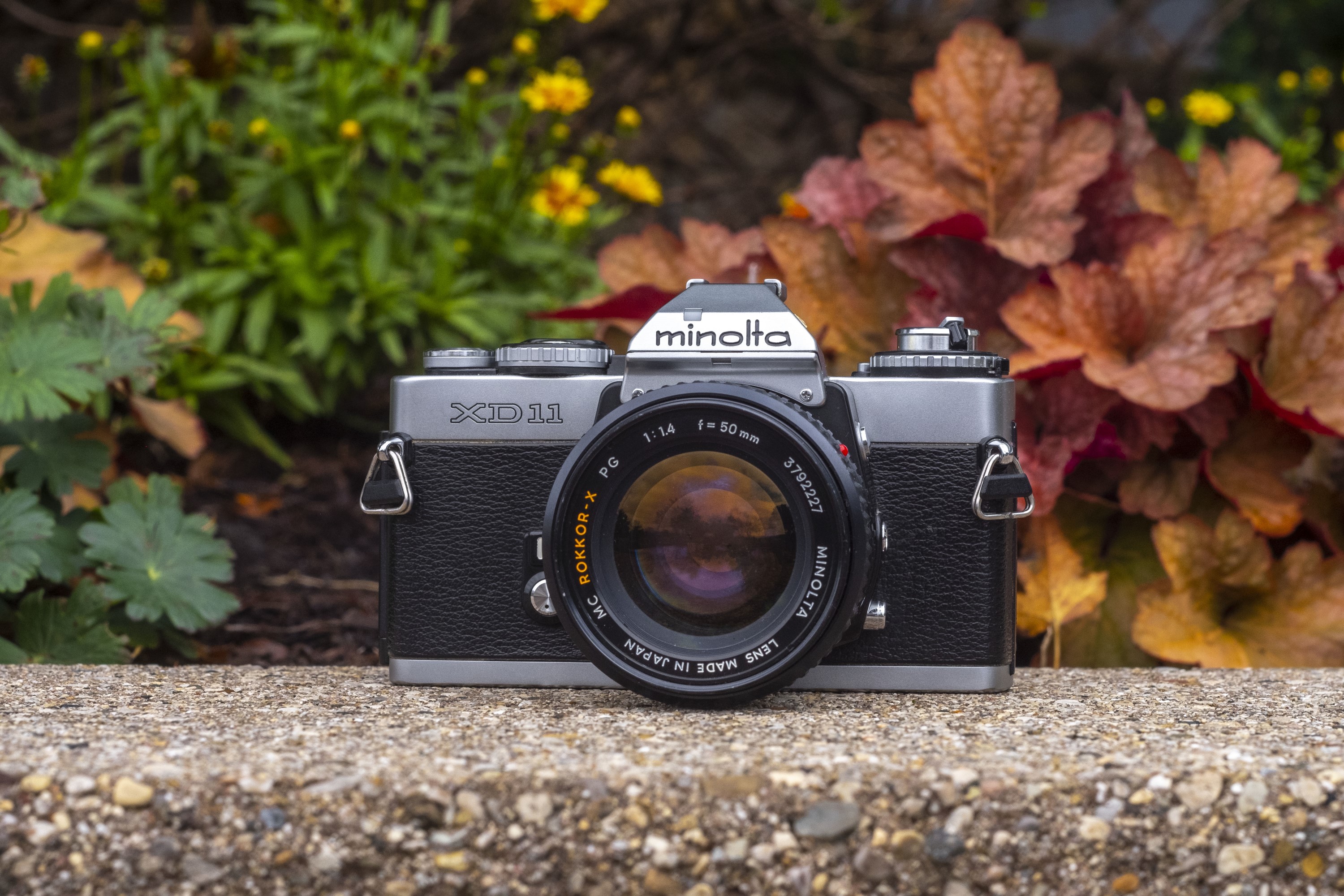
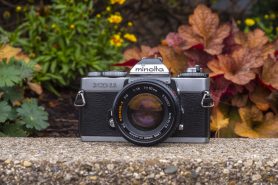
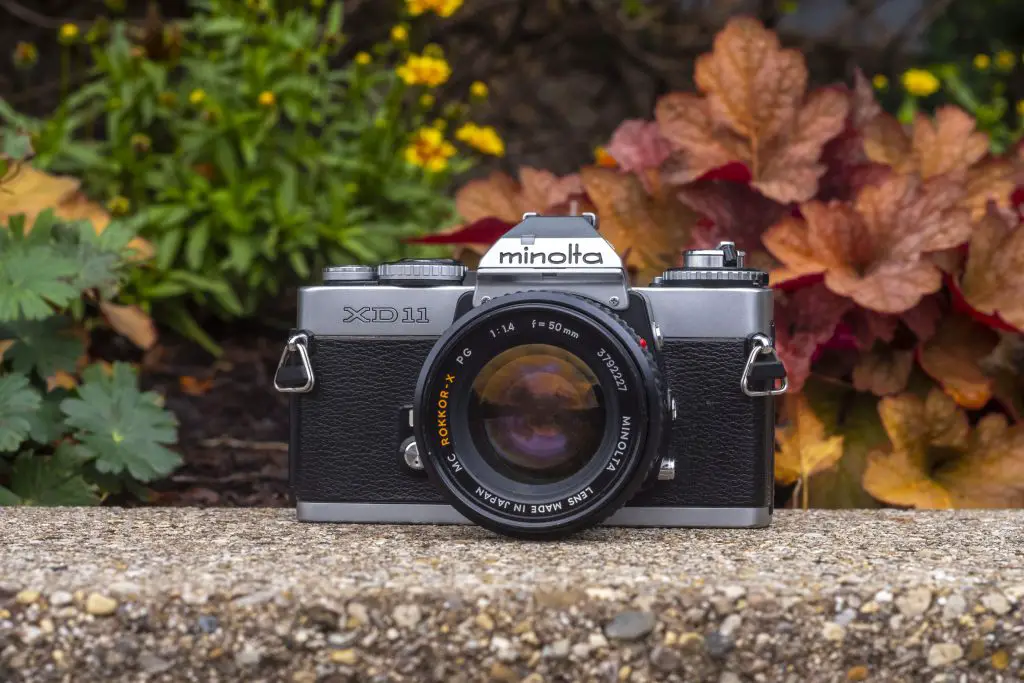
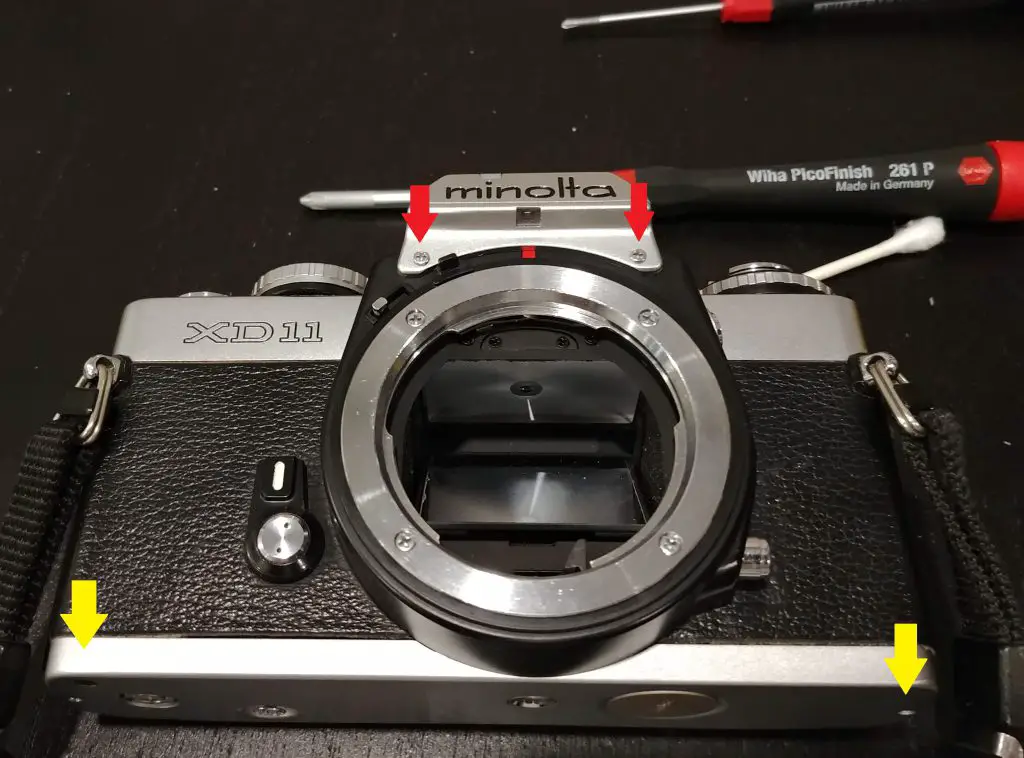
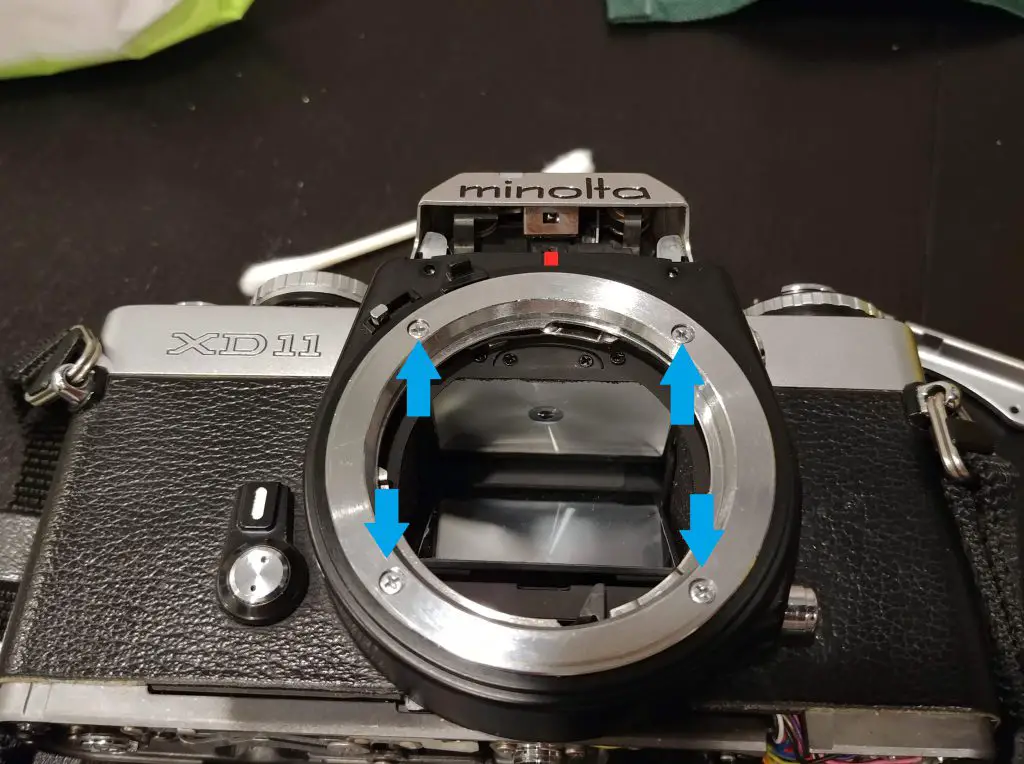

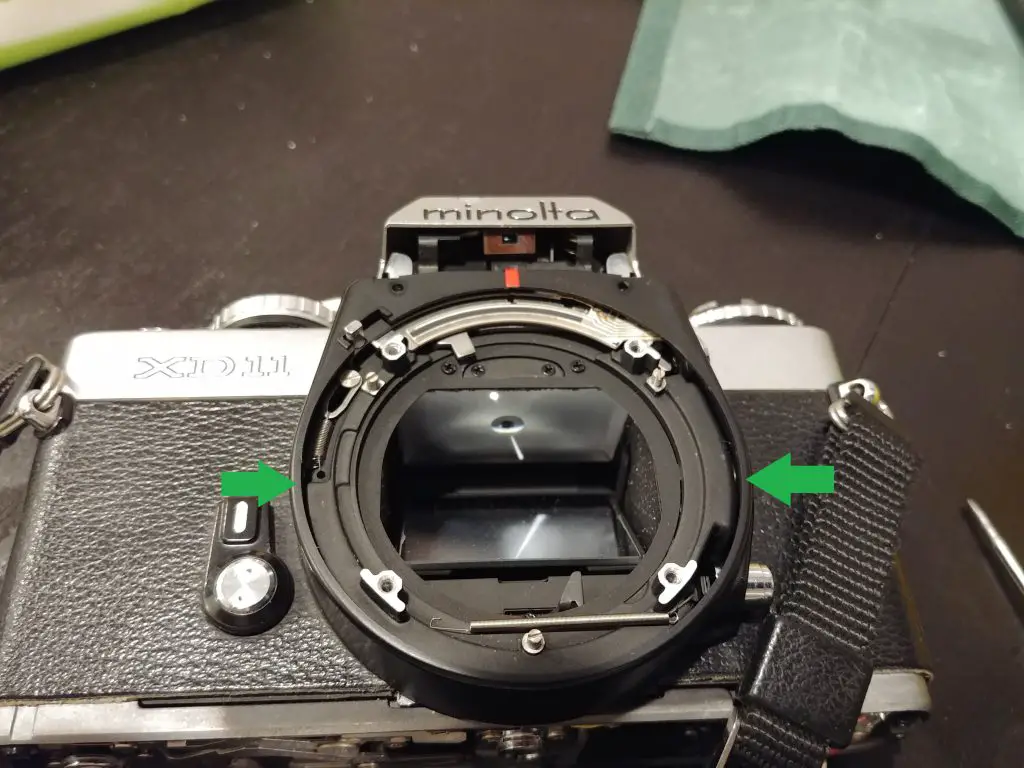
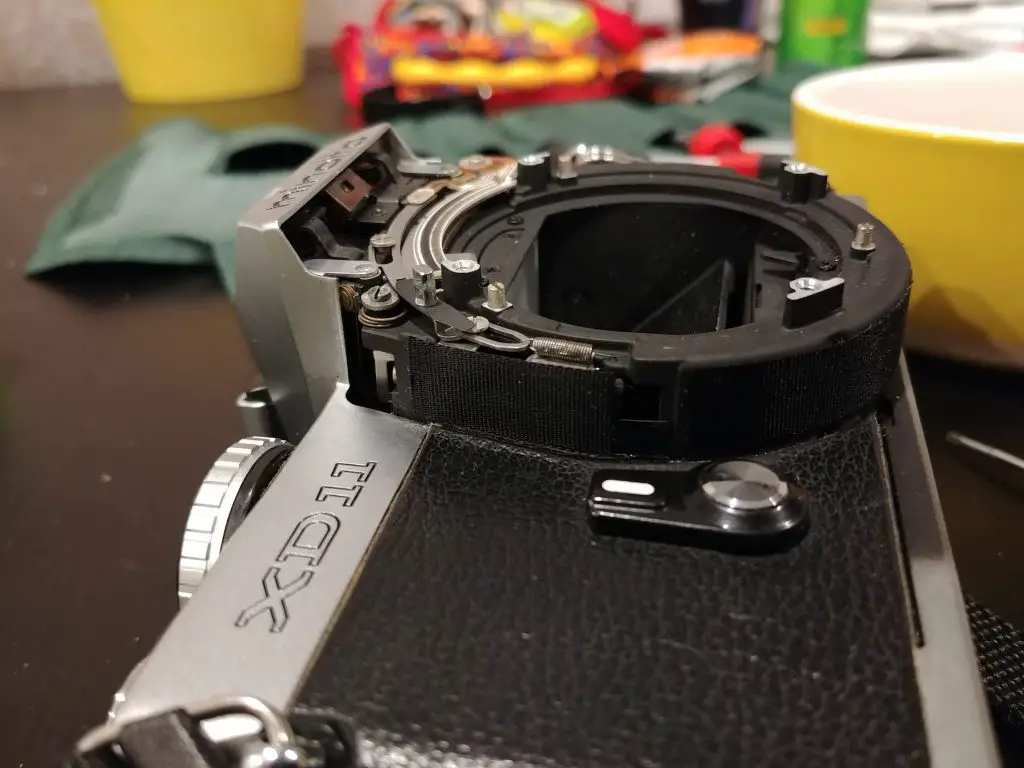
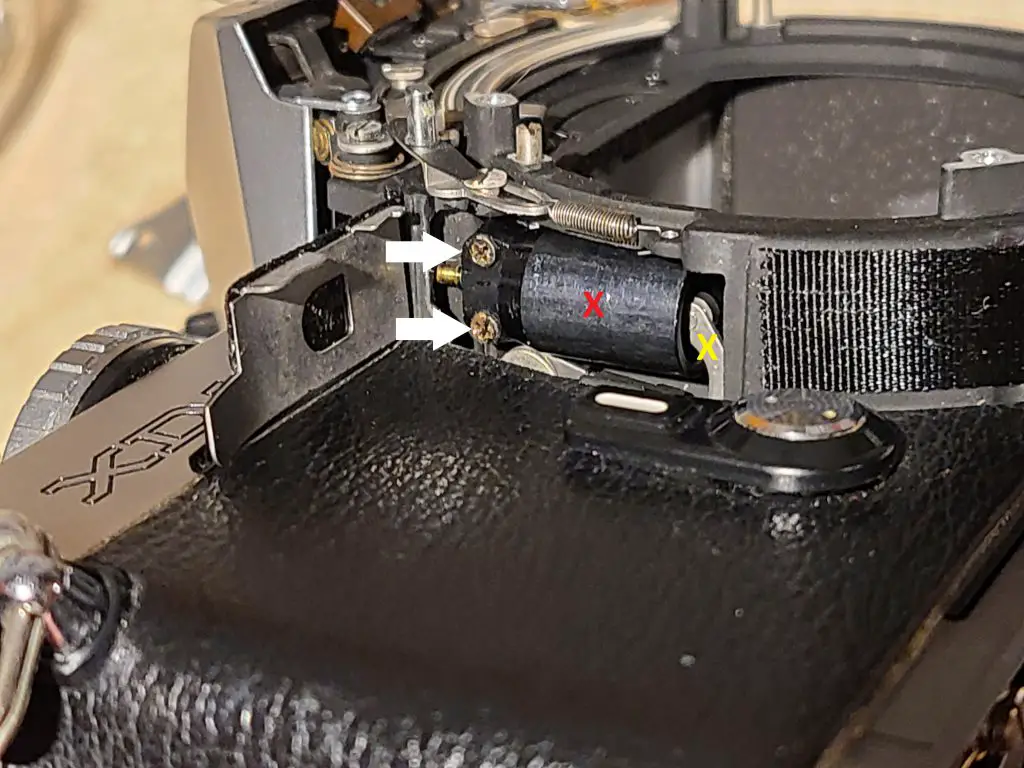
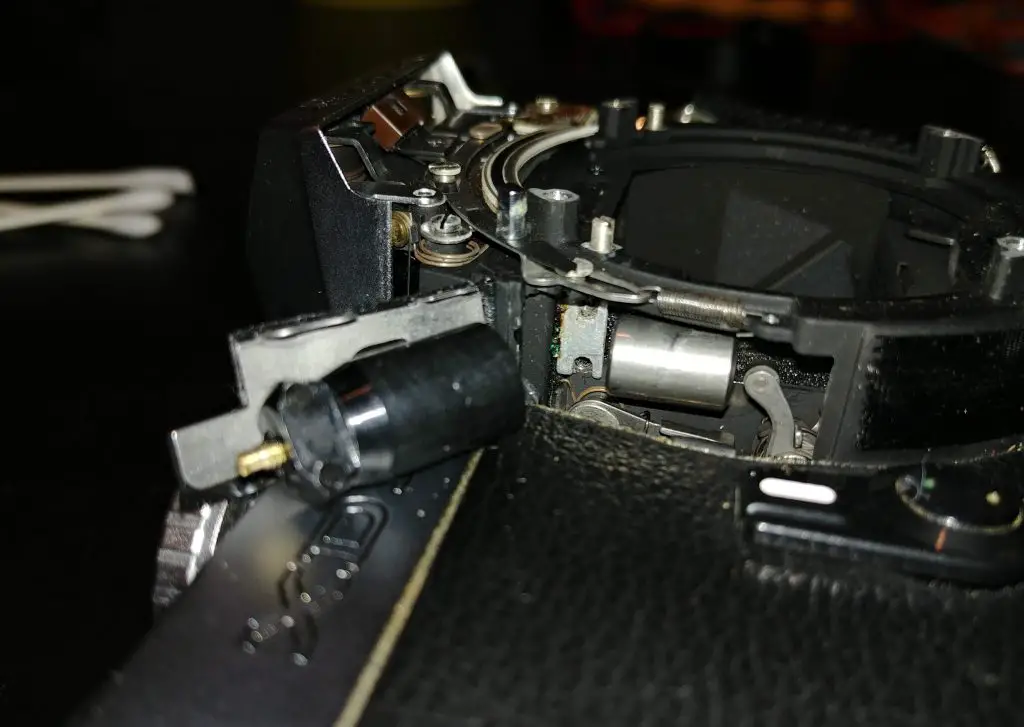
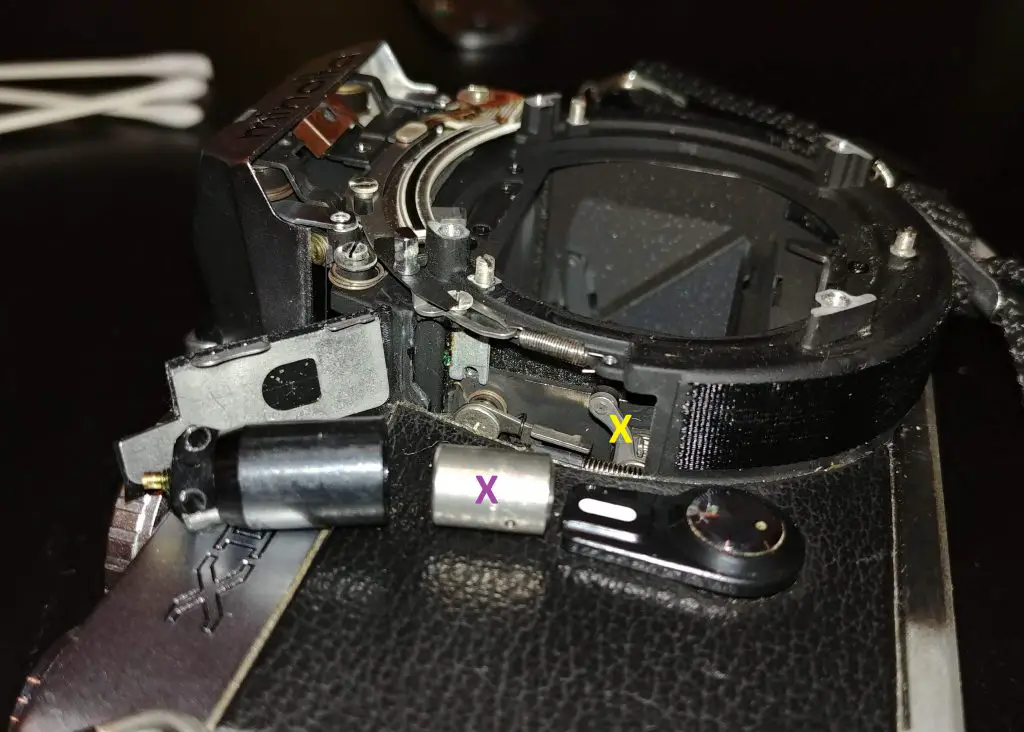
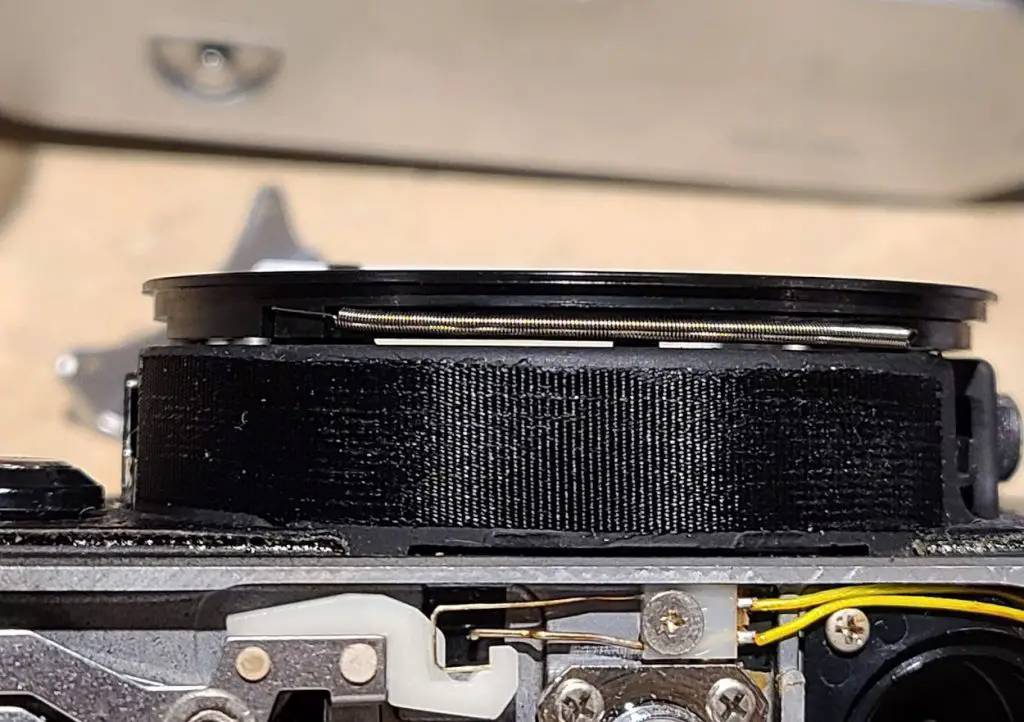
































The film advance lever on this camera is truly something, the XE one is even better but on the XD the silky advance lever and the dampened shutter make for a very quiet camera.
Great review !
This is also one of my all-time favorite 135mm cameras. Those with black finishes look and feel even better. And the synthetic body covering shrinkage issue was solved in late productions.
You’ve summed up this delightful camera very well, Mike.
I first came across reference to it in a small UK publication covering cameras of note in the history of photography, when it was included as the very first model to incorporate both aperture and shutter priority auto, plus metered manual. The entry also covered the dedicated winder and flash unit that could keep pace with 2fps. This was around 1980/81 and I was in the market for a replacement slr. All my cameras up to this point had been either fully manual or metered manual, so this looked very tempting indeed. I happened upon a mint example with the f1.4, winder and flash for a very fair price. To my joy, I found it a pleasure to use and was really surprised by the large and bright v/f that made focusing a doddle.
This subsequently gave way to a Leica R3 a few years later, but I kept the XD7, and the R3 as my camera collecting habit was well under way, as an historically important camera and I still like to get it out and play with it to this day, albeit I no long shoot film. I am a digital convert, but it is cameras like this that make me realise I wouldn’t be missing anything if digital had never come along!
I had 2 of the XE 5, and both came up limp with shutter issues that could not be repaired. I have the XD 11 with the flash, had my camera tech go over it and never looked back. I have way to many lenses for it and adapt many on my A7.
Great article, as always. I’m not sure if you are aware of this, but there are some interesting associations with Germany that are embodied in the name Minolta and its predescessors.
Minolta has a long and storied history. Kazuo Tashima studied economics and sociology in Tokyo, spent a short time working at a newspaper, then joined his father’s trading company, which allowed him to spend time in London, Paris and Berlin. At the age of 28 he founded Nichidoku Shashinki Shoten (translated means Japan-German Camera Store) on November 11, 1928 in Osaka, Japan. He had the help of two German engineers Billy Neumann and Willy Heilemann. The cameras were Japanese made, but tended to use German lenses and shutters as the technology to make them in Japan hadn’t really developed yet. Camera names from this era all start with the word Nifca, which was derived from (NI)ppon (F)oto (CA)meras.
In 1931 the company name changed to Molta Goshi-gaisha. Molta stood for (M)echanismus (O)ptik und (L)insen von (TA)shima. The product names were changed. They continued to handle the marketing of their own cameras until an agreement was reached with Asanuma Shokai. (The Sirius and Arcadia were also distributed up to this point by Misuzu Shokai as the Lomax and Eaton). When Asanuma took over distribution the camera model names changed again. In 1931 and 1932 the German engineers left to form their own company, Neumann and Heilemann.
The name Minolta was registered in 1933, and first used on a camera that was very similar the the Plaubel Makina. It has been suggested that Minolta was derived from (M)echanismus, (IN)strumente, (O)ptik und (L)insen von (TA)shima” (“Mechanism, Instruments, Optics and Lenses by Tashima”).
https://pacificrimcamera.com/pp/minolta.htm
Many thanks, Mike, for an excellent and thorough overview of this magnificent camera. (Thank you, especially, for including the reviews from the time of the camera’s original release in 1977. Greatly appreciated.) After reading your article I fired off a couple of frames on my body to check your complaint about the shutter lag issue, something that I’ve always understood to be a factor in the design of the XD models. My examples were neither as slow as yours in the first YouTube video nor as fast as yours in the second, which only tells me that I have nothing to worry about as far as my exposures are concerned. All of the literature that I’ve ever read about the XD mentions the double-check metering system (p.25 and p.56 in the manual), which introduces a very slight (and usually noticeable) delay in the opening of the shutter after the pressing of the release. I am not a sports shooter or even a wedding photographer, so my photography has never been affected by this quibble about the XD7. (If I were to become a wedding photographer then I would choose to use my Nikon Df.) I have owned my XD7 for more than ten years and my XE-1 for perhaps half of that time and I use both cameras just as they were intended, as solid classic cameras for the serious and careful making of film photographs. The Minolta glass is magic in the right light, adding a layer of density and rendition that I usually only otherwise see in photographs that were made with Leica lenses. The Minolta XD7 is, indeed, just about the best-featured and most sensibly-operated camera from the analogue era, not least because it can always make an acceptable exposure by the use of its dead speed. My first camera, thirty-six years ago, was a Minolta X-500; so, I know that I can be accused of sentiment in my hailing of the XD. In all seriousness, however: This camera is still much more useable, reliable and serviceable than many of the whiz-bang superstars that came along later, including from Minolta. I am always glad that I bought mine. – Christopher, from Melbourne in Australia
Great story, Chris! Thanks for sharing it. It is stories like this, that makes me want to continue writing about these old cameras. Hearing the attachment some people have to a particular model or recalling some memory from long ago makes it all worthwhile!
I owned this camera when it was new and I really wanted to like it because I was a Minolta employee. Unfortunately, there were too many annoyances, especially the shutter lag, that made me regret owning it. The good points were the soft shutter release, quiet operation, decent viewfinder, good Rokkor lenses and tons of features. The bad points were the severe shutter lag in all modes (some worse than others), noisy and junky power winder, soft vinyl leatherette that felt good but couldn’t hold up to daily use, and the lack of repair capability in the US (they shipped them back to Japan for the first 6 months).
It is interesting you talk about the shutter lag which is something I comment about in the review as it seems to get worse over time. There are certainly things people can do today to make it better, but I wouldn’t have thought it would be that noticeable when the camera was new. I know Minolta went to great lengths to quiet down the sound of the mirror moving, but perhaps they took their dampening too far? In either case, as a collector today, its a terrific camera for general photography, but when you need something ‘snappier’ just get an XE7! 🙂
I just picked up an XD11 in excellent condition, except the detent in the ASA ring is kaput, so a bit of gaffer’s tape holds it still. I have yet to run film through it but will in a couple of weeks. Feels pretty nice in the hand though.
That was a very informative account you gave there. Thanks. I just wanted to add, Canon released the AE-1 in 1976, Minolta responded with the XD in 1977. Then Canon fired back with the A-1 in 1978. All 3 cameras had the latest silicon cell metering but the Canon’s had horizontal travel rubberized cloth shutter curtains and 1/60th x sync while the Minolta had the more advanced vertical travel metal shutter and 1/100 (slightly better) x sync. as well as a manual shutter speed and much studier construction. But Canon certainly had the better advertising at the time.